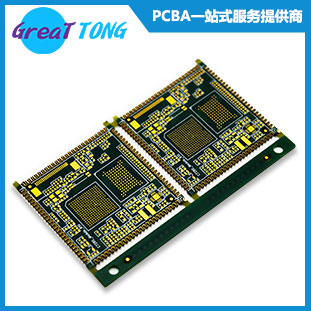What is ENIG?
ENIG (Electroless Nickel Immersion Gold), is a kind of (finished) process used for surface treatment of circuit board. It is generally referred to as "nickel-impregnated gold plate" or "gold-impregnated plate", which is widely used in the PCB fabrication.
What is the difference between ENIG & electroplating nickel and gold?
Compared to electroplating nickel and gold, the nickel impregnated gold does not need to be electrified on the cirCuit board during the process of the cirCuit board factory, nor does it need to be connected to each pad to be electroplated in order to be plated with nickel gold, so the process is relatively simple. Production is also multiple, so production costs are relatively cheap.
However, ENIG surface treatment also has its shortcomings and problems, such as low welding strength, which is easy to produce black pad, that is often criticized by people.

How about the production process of chemical nickel and gold?
Pre-treatment: oil removal, water washing, pickling, water washing, chemical nickel (ni/p) leaching, gold plating, gold recovery, water washing, preprepreg (h2so4), water washing, preimmersion (PD catalyst), chemical nickel (ni/p) leaching, gold plating, gold recovery, water washing and drying.
Pretreatment: the aim is to remove oxides from copper surface and roughen the surface of copper in order to increase the adhesion of nickel and gold.
Micro-etching: sodium persulfate / sulfuric acid to remove the oxidation layer on the copper surface and reduce the groove depth caused by brushing during pretreatment. Too deep brushes often become an accomplice in gold-immersion attacks on nickel layers.
Activation: since the copper surface cannot directly initiate the deposition of chemical nickel, a palladium (pd) layer must be added to the copper surface as the catalyst for the chemical nickel deposition reaction. Based on the principle that Cu is more active than PD, palladium ion is reduced to palladium metal and attached to copper surface.
The chemical nickel: ni-p, whose main function is to block the migration between copper and gold, (migration) and diffusion (diffusion), and as an element to react with tin in subsequent welding to form imc.
Gold plating: the main purpose of gold is to protect and prevent the oxidation of nickel coating. Gold does not take part in chemical reaction during soldering, and too much gold actually hinders the strength of solder, so gold can only cover the nickel layer so that it is not oxidized easily. This is not the case if you want to line out cob (chip on board) because the gold layer must be thick enough.
What are the advantages of ENIG surface treatment?
1.Its surface treatment can be used as the bottom metal for cob wiring.
2.Multiple reflow welding can be performed repeatedly, generally requiring at least 3 high temperature welding resistance, and the welding quality can be maintained.
3.Excellent electrical conductivity. Can be used as a key-on-gold-finger cirCuit, and high degree of trust.
4.The gold metal has low activity and is not easy to react with the components in the atmOSPhere, so it has the ability to resist oxidation and rust. As a result, ENIG can be kept for more than six months. Sometimes, even if it is stored in a warehouse for more than a year, as long as it is in good condition and there is no problem of rust, CirCuit board after baking dehumidification and weldability test to confirm that no problem, or can continue to use to weld production.
5.Gold is also not easily oxidized in the air, so a large area of bare (pad) can be designed for "heat dissipation."
6.It can be used as the contact surface of the blade plate. The gold plating for this application must be thicker. It is generally recommended that hard gold be plated.
7.The surface of ENIG is flat, printing tin paste is smooth and easy to weld. Very suitable for fine foot parts and small parts, such as BGA, flip-chip and other parts.
What are the disadvantages of ENIG surface treatment?
Generally speaking, the solder joint strength of ni3Sn4 is lower than that of Cu6Sn5, and some parts with special welding strength may not be able to withstand excessive external force and risk of falling off.
1. Because the price of gold is rising, so the cost is higher than OSP surface treatment.
2. There is a risk of "black pad (black pad)" or "black nickel", once the black pad formation will cause a sharp decline in solder joint strength.
The black pad is composed of complex nixoy chemical formula. The fundamental reason is that the nickel surface is replaced by leaching gold. The nickel surface is subjected to an excessive oxidation reaction (the free nickel metal can be referred to as oxidation in a broad sense), and the large gold atoms (144pm) are deposited irregularly to form coarse and porous grains.
In other words, the "gold" layer does not completely cover the "nickel" layer under it, giving the nickel layer the opportunity to continue to contact the air, and finally forms nickel rust under the gold layer, resulting in welding obstacles. At present, there is a process of "nickel-impregnated palladium gold (enepig)" which can effectively solve the problem of "black pad", but because its cost is still relatively expensive, so far only high-order plate / CSP or BGA manufacturers have adopted it.








